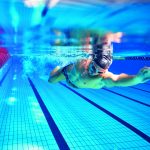10 drills to improve your coordination
When we swim we hope that the movements we make are as close as possible to the motor project we had in mind just before we started.
How close these movements are to how we imagined them reflects are coordination skills in the water.
These skills come on two levels: general and special.
While the former concern the movements themselves from the learning process to full control of our motion, the latter are connected with our abilities and, hence, the possibility of performing these movements at a certain rhythm, in a certain position (balance), in response to a certain signal, realising what degree of intensity of action our muscles are undergoing and for how long they must/will have to keep it up.
If, while you are swimming, you notice that your arm is entering the water “with a low elbow”, it will be your coordination skills that allow you to correct this mistake.
If you want to improve your start, swim stroke or turn, you will always have to rely on these skills, which, obviously, are just as important as your physical attributes (strength, stamina, speed).
The best age to improve your coordination ranges from 7-13/15 years, but do not despair, there is no specific age limit that will prevent you from improving them if you perform good drills on a regular basis.
Here is a set of drills to be performed over short distances (25 m) with each drill to be performed no more than four times.
EXAMPLE: 2 x (12 x 25 with 15”/20” recovery, 4 for each drill + 200 pullbuoy breathing every 5-3 strokes with 30” recovery)
1. Freestyle swimming with 4 arm strokes at surface level and three strokes at a depth of 1 m.
2. Backstroke with breaststroke legs (one leg kick every arm stroke) turning your head to the right when you use your left arm and vice-versa.
3. Freestyle with two recoveries before your hand enters the water (let your hand skim across the water during the first recovery and keep your arm extended during the second)
4. Freestyle with breaststroke legs breathing first to the left and then to the right.
5. Butterfly with clenched fists, extended arms and freestyle legs.
6. Backstroke: perform three arm strokes and two front crossovers (when one hand is along your side and the other in front of your head, keep them extended as during the recovery phase and describe two semicircles crossing your hands over in front of your nose).
7. With freestyle legs perform 1 freestyle arm stroke with your right arm and 2 strokes with your left (1 breaststroke, 1 freestyle) then two arm strokes with your right arm (1 breaststroke, 1 freestyle).
8. Swim backwards: push off the wall with your hands, swim freestyle in a prone position (rotate your arms backwards as if you were swimming backstroke and do not kick your legs) breathing once to the right and once to the left.
9. Swim freestyle with 4 fast arm strokes and 4 slow strokes, 3 fast and 3 slow, 2 fast and 2 slow, 1 fast and 1 slow.
10. Swim 1 breaststroke arms and 1 butterfly arms.
My first coach always used to tell me: learn how to swim properly, when you have mastered that you will already be better than you think.
Shall we try?
Written by:
arena coaches
Swim coaches, trainers and experts will give you all kinds of tips for performing at your best in both training and races.







